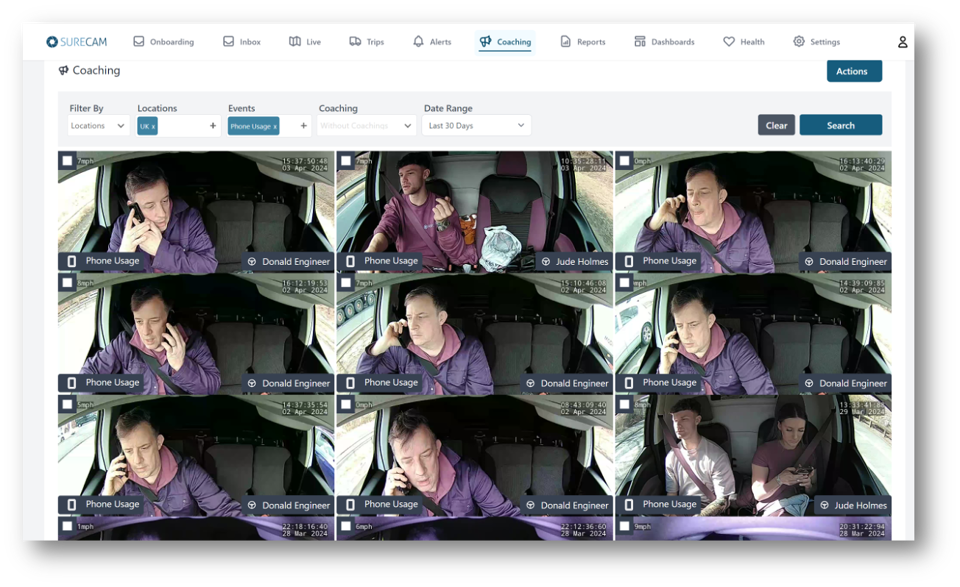Driver-facing cameras hit the headlines earlier this month when Asda “indefinitely halted” plans to install the technology in its home delivery vans following union opposition.
The supermarket giant had intended to introduce the technology to improve safety, with the artificial intelligence-equipped cameras able to identify areas of risk such as driver tiredness and distracted driving
The GMB said it had serious concerns that the use of the cameras amounted to a severe breach of privacy and unnecessary intrusion on a driver while at work.
In many cases, however, drivers are keen to embrace the benefits of the systems and a recent Samsara survey of 500 commercial drivers found 55% identified AI-powered distraction detection as a tech solution they want on the road.
“Highlighting the tangible benefits of dash cams is a great way to foster driver support,” says Philip van der Wilt, vice-president for Europe, the Middle East and Africa (EMEA) at Samsara.
“Sharing real-world examples of how dash cams have exonerated drivers or contributed to safer outcomes can demonstrate their value.
“And when drivers understand how these tools directly benefit them, they’re more likely to embrace the technology.”
Driver-facing cameras hit the headlines earlier this month when Asda “indefinitely halted” plans to install the technology in its home delivery vans following union opposition.
The supermarket giant had intended to introduce the technology to improve safety, with the artificial intelligence-equipped cameras able to identify areas of risk such as driver tiredness and distracted driving
The GMB said it had serious concerns that the use of the cameras amounted to a severe breach of privacy and unnecessary intrusion on a driver while at work.
In many cases, however, drivers are keen to embrace the benefits of the systems and a recent Samsara survey of 500 commercial drivers found 55% identified AI-powered distraction detection as a tech solution they want on the road.
“Highlighting the tangible benefits of dash cams is a great way to foster driver support,” says Philip van der Wilt, vice-president for Europe, the Middle East and Africa (EMEA) at Samsara.
“Sharing real-world examples of how dash cams have exonerated drivers or contributed to safer outcomes can demonstrate their value.
“And when drivers understand how these tools directly benefit them, they’re more likely to embrace the technology.”
Any initiative to introduce driver-facing cameras should start with clear and open communication with unions and drivers.
They need to understand how the cameras work, who has access to the footage, how it will be used, how long it is stored for and for what purpose.
“Engaging drivers and unions early in the process is an important step, allowing their input to be considered and their concerns addressed,” says Chris Horbowyi, commercial director of Targa UK.
Transparency is key to building and maintaining trust, while it will also combat anxiety: fleets do not want drivers to be thinking about the camera while they are driving, they want them focused on the road.
Any use of the footage should be strictly confined to legitimate, clearly-stated objectives, such as improving road safety or clarifying liability in an accident.
Overcoming opposition
“It took a while to get our drivers on board, as the inward-facing cameras can feel like an invasion of privacy,” says Lauren Austen-Nash, head of fleet compliance at Countrystyle Recycling.
“We couldn’t just switch everything on at once. We had to move forward carefully, and show that we’re using the cameras for their own protection in order to gain that foundation of trust.”
Kelly Group introduced AI-powered driver-facing cameras to tackle driver distraction, which is “our biggest concern and our biggest reason for having accidents”, says Dermot Coughlan, fleet director at Kelly Fleet Services.
“We didn’t really run into any problems when we introduced the cameras because when we recruit people, we tell them ‘this is how it works, this is what we’re doing’,” he adds.
“It’s in the driver handbook, which is also our driving policy, and the drivers sign it to say they know there’s a vehicle management system – which is how we describe our telematics and camera systems – in there, which will record information and monitor behaviour.”
Kelly Fleet Services has set its system up to provide notifications when an incident has been detected, such as not using a seatbelt, smoking, use of mobile phones or fatigue.
“We only look at the footage when the system sends us a notification,” says Coughlan. “We use it purely for safety.
“When we’re sitting down with the ops guys, the board or whoever we need to talk to, we explain that the vans are work tools and we need to make these work tool as safe as possible for whoever is driving them – and not hurt anybody else while they’re at it.”
Strict data regulations
While in the Asda case – and in many other instances - the union raised concerns over invasion of privacy, but there are a number of strict regulations organisation need to comply with when cameras are introduced. These include the 2018 Data Protection Act, GDPR and the Human Rights Act.
The Information Commissioner’s Office (ICO) provides specific guidance on dashcams and GDPR, and fleet operators should review this guidance for additional clarity.
“It doesn’t need to be all or nothing,” says an ICO spokesman. “If you decide to install a camera that has audio capability, switch this feature off by default and use it only in exceptional circumstances.
“It’s intrusive, which means you need strong justification for using it, for example, if there’s a threat to personal safety.
“Similarly, if your business vehicles are used for personal journeys, the cameras should be switched of during non-working hours.
“This also applies if you install a camera in an employee's personal vehicle that they’re using for your business journeys.”
Kelly Fleet Services has turned off the microphones on its system so any personal conversation is not being recorded.
“We may lose some information there but, at the end of the day, if someone is driving into someone else you can tell whose fault it is, so you don’t really need to know what he was saying,” adds Coughlan.
The ICO says all data generated by the cameras should be stored securely to comply with data regulations, making sure you have considered things like password protection and limiting access to your systems only to the people who need to see it.
At Kelly Group, access to the footage is limited to a handful of people. “For example, my MD doesn’t have access to it,” says Coughlan. “Only the risk management team have access to it and they don’t share it with anybody else unless it’s absolutely necessary.”
The ICO also recommends the footage should be deleted when you no longer need it. “There’s no one-size-fits-all when it comes to how long you should keep data,” says an ICO spokesman.
“Generally speaking, if you’re holding several weeks’ worth of recorded footage just in case you need it, that’s probably too long.
“Many small businesses record in case there’s an accident and the footage could help settle insurance claims.
“If there hasn’t been an accident, and you have no other reason to keep the footage, you should probably delete it after a week or so.”
Login to continue reading.
This article is premium content. To view, please register for free or sign in to read it.
























Login to comment
Comments
No comments have been made yet.